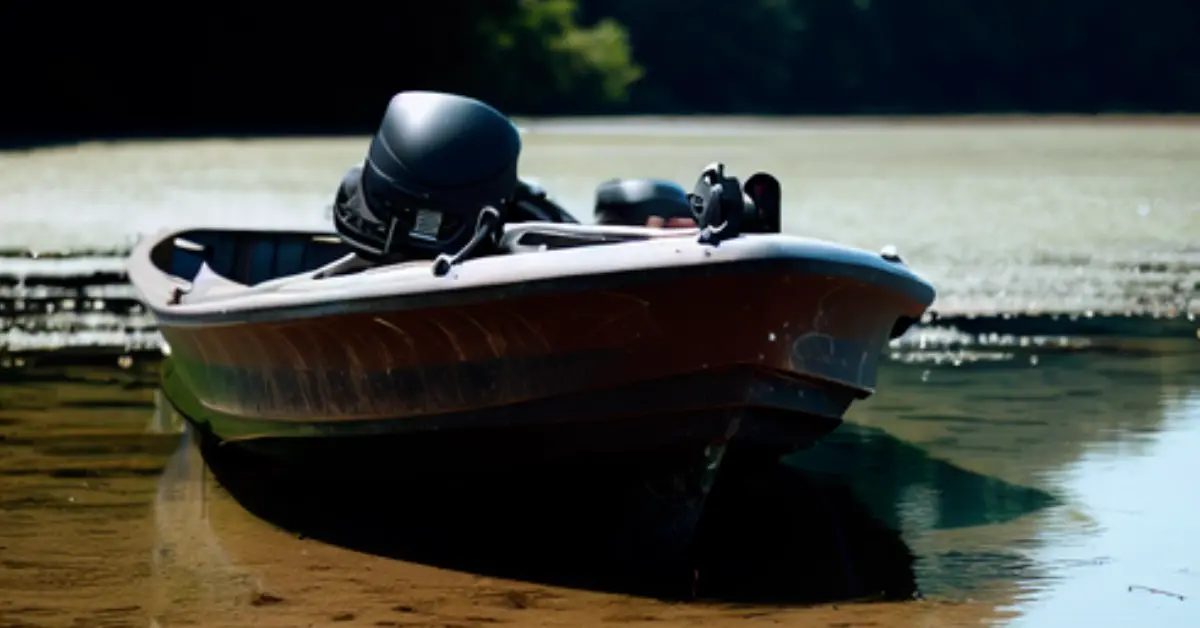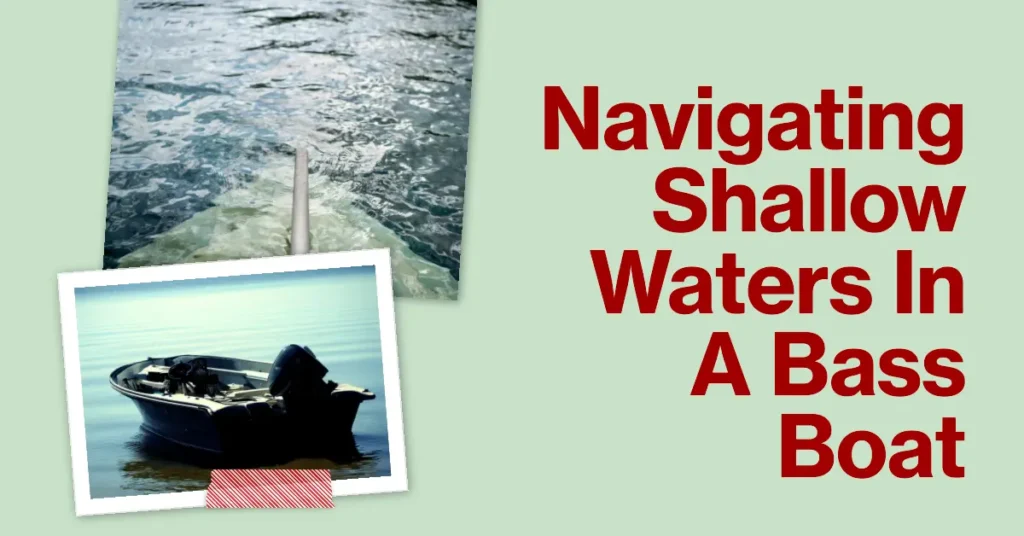A bass boat can go as shallow as 12 inches in water depth, allowing anglers to navigate through tight spaces and shallow areas easily.
On average, a bass boat can safely navigate in water that is about 1 to 2 feet deep. However, this can vary. Some smaller and lighter bass boats can go in water as shallow as 10 to 12 inches, while larger and heavier bass boats might need at least 2 to 3 feet of water.
One crucial aspect of bass fishing is the ability to navigate shallow waters. A shallow water bass boat is designed with a flat-bottom hull, which allows it to float in incredibly shallow depths.
The shallower the boat can go, the more access it provides to prime fishing areas that cannot be reached by other types of boats.
This capability is essential for anglers who want to explore hidden coves, shallow flats, and backwater areas where bass often gather.
In this guide, I will explore how shallow a bass boat can go and the factors that determine its shallow water performance.

Table of Contents
Here’s how each factor can affect how shallow a bass boat can go:
- Boat Design: Flat-bottomed boats, which are common designs for bass boats, can often navigate in water as shallow as 1 foot or even less. This is because their flat design distributes the weight evenly and allows them to float higher in the water.
- Boat Size and Weight: A smaller, lighter bass boat might be able to navigate in water as shallow as 10 to 12 inches. However, a larger, heavier bass boat, especially when loaded with equipment and passengers, might require at least 2 to 3 feet of water to navigate safely.
- Draft: The draft of a boat is directly related to how shallow a boat can go. A bass boat with a draft of 1 foot will need at least that much water depth to avoid running aground.
- Engine and Propeller: Bass boats with outboard motors that can be tilted up can often navigate in shallower water than those with inboard motors. Depending on the propeller design and the ability to tilt the motor, some boats might be able to navigate in water as shallow as 1 foot or less.
- Water Conditions: In calm, clear water without obstacles, a bass boat might be able to navigate in very shallow water, perhaps as little as 1 foot or less. However, in water with strong currents, waves, or underwater obstacles, more depth might be needed for safe navigation.
- Boat Operator Skill: An experienced boat operator might be able to safely navigate a bass boat in water as shallow as 1 foot or less by reading the water conditions and adjusting the boat’s speed and direction accordingly. However, less experienced operators might need more water depth to navigate safely.
Disclaimer: These are just estimates and the actual depth a particular bass boat can navigate in can vary based on a combination of these factors. Always check the specifications of your specific boat and use caution when navigating in shallow water.
You may also like to know:
- Where to Mount Transducer on Bass Boat? (How to insatll?)
- How Much is Bass Boat Insurance cost in 2023?
- How to Drive a Bass Boat? [Ultimate Guide]
- How Much Does a Bass Boat Weigh With Trailer?
Water Depth And Clearance For Bass Boats
It is important to determine the minimum water depth required for your boat to avoid any potential hazards. Knowing the water depth allows you to choose the right route and avoid running aground or damaging your boat’s hull.
There are various tools and techniques available to measure water depth, such as depth finders and nautical charts. Using these tools and regularly monitoring the water depth will ensure a smooth and enjoyable boating experience.
Navigating shallow waters in a bass boat can be tricky, but with the right techniques and precautions, you can do it safely and effectively.

Here are some tips:
Know Your Boat’s Draft:
Understanding the minimum depth your boat requires to operate safely is crucial. This will help you avoid grounding the boat or damaging the propeller.
You can Use a Depth Finder:
A depth finder or fish finder with a depth gauge can be an invaluable tool for navigating shallow waters. It can help you monitor the depth of the water and avoid areas that are too shallow for your boat.
Go Slow:
When you’re in shallow water, it’s best to reduce your speed. This gives you more time to react to obstacles and reduces the risk of damage if you do hit something.
Trim Your Motor:
If your boat has an outboard motor, trim it up when in shallow water to lift the propeller higher and reduce the risk of it striking the bottom.
Watch the Water:
Look for changes in the color or texture of the water that might indicate shallower areas. Also, be aware of waves or ripples that can indicate the presence of underwater obstacles.
Plan Your Route:
If possible, plan your route in advance to avoid the shallowest areas. Use charts or maps if available.
Use a Push Pole:
In very shallow water, you might need to turn off your motor and use a push pole to move your boat. This can help prevent damage to your motor and propeller.
Pro tip: Safety should always be your top priority when boating. Always wear a life jacket, and be aware of the weather and water conditions.
Frequently Asked Questions:
How Shallow Can A Bass Boat Go In The Water?
A bass boat can typically navigate in water as shallow as 2 feet, depending on the boat’s design and hull type. However, some specialized bass boats with shallower drafts can go in water as shallow as 12 inches or less, allowing anglers to access shallow areas where bigger boats cannot go.
Can A Bass Boat Handle Rough Water Conditions?
While bass boats are designed for freshwater fishing, most modern models are built to handle moderate rough water conditions, such as choppy lakes or rivers with mild waves. However, it’s important to note that extreme rough water, such as large ocean waves, is not suitable for bass boats and can pose safety risks.
How Fast Can A Bass Boat Go?
Bass boats are known for their speed and can reach impressive top speeds. Most bass boats can reach speeds between 60 to 70 miles per hour with a powerful outboard motor. The actual speed, however, can vary depending on factors such as boat size, weight, engine horsepower, and weather conditions.
What Advantages Does A Shallow Draft Offer?
A shallow draft allows a bass boat to access shallow waters, which are often rich in fish and other aquatic life. This gives anglers the advantage of being able to navigate through narrow channels, grassy flats, and shallow coves where larger boats may struggle to go.
Additionally, a shallow draft allows for easier maneuverability in tight spaces.
Can A Bass Boat Be Used For Other Activities Besides Fishing?
While bass boats are primarily designed for fishing, they can also be used for various water activities such as waterskiing, tubing, and cruising. Some models come with additional seating and features that make them more versatile for recreational use. However, it’s important to ensure that the specific bass boat is suitable for the desired activity.
Conclusion
If you consider factors like hull design, water conditions, and the boat’s draft, you can determine how shallow you can venture. Bass boats equipped with features like shallow water anchors and jack plates can provide added maneuverability and access to ultra-shallow areas.
However, it is important to strike a balance between pushing the limits and avoiding damage to your boat or the environment. By employing techniques such as trimming the motor, using a depth finder, and reading the water’s surface, you can increase your chances of successfully navigating shallow waters while minimizing risks.
